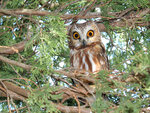
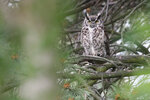
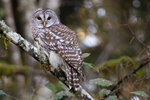
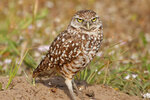
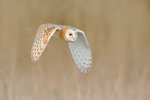
One weekly radio program I occasionally listen to is Science Friday. My smartphone, knowing my interest in birds, alerted me that Science Friday last week included an interview with the author of a new book about owls https://www.sciencefriday.com/articles/what-an-owl-knows-book/. This, in turn, reminded me that I had not written about owls recently.
Owls certainly hold much interest for us humans. They often have roles in myths and stories and are assigned human characteristics (think “wise, old owl”). I suspect that their habit of perching upright with two large eyes facing forward encourages us to think of them as human-like and, of course, being primarily nocturnal makes them inherently mysterious.
Although we seldom see them, multiple species of owls are common residents in Thurston County. The two largest, and most vocal, are the Great-horned Owl and the Barred Owl. Both these species began nesting in late winter and now their young have fledged (that is, they have grown flight feathers and left the nest). But that doesn’t mean they are not still dependent on their parents.
This is the season when these young fledglings can be heard vocalizing to their parents (it’s a squawking call that serves as begging for food). You might hear this call at any time in a wooded area, but most frequently in the evening; they’re hungry after sleeping all day and want mom or dad to bring them food. This will go on for another month or so. By then, the young owls will need to catch their own dinners – which won’t stop them from continuing the begging. I leave it to you to decide whether that behavior is also human-like.
Barn Owls are also common in our area and, true to their name, they use old barns with open entrances near the roof as convenient breeding and loafing sites. Since Barn Owls feed on rats and mice, they earn their keep. Farmers for generations have provided breeding sites for them, putting up with the feces and owl pellets that accumulate below.
Barn Owls are talented hunters and can capture prey using only sound. Researchers placed test owls in a totally dark room and released a mouse. The owls were able to capture the mouse by listening to the sound of its feet alone. Owls, especially the Barn Owl, have facial feathers to form a disc; these feathers have muscles that direct sound to their ear openings. And these openings are asymmetrical; they are located at different heights and oriented in different directions. Thus, the Barn Owl can use sound from different angles to effectively locate prey even when they cannot actually see that prey.
The feathers of owls overall facilitate their nocturnal hunting life. They have large wings in proportion to their body size, and their fluffy feathers weigh less than many other birds, making the burden of flight less difficult. Beyond gentle wing beats, their wing feather sets have comb edges that serve to break up the sound vibrations of their flight. Their silent flying enhances their mysterious reputation.
The new book discussed on Science Friday is What An Owl Knows: The New Science of the World’s Most Enigmatic Birds by Jennifer Ackerman. This book discusses many different owl species from around the world, including a small owl species that we have locally, the Northern Saw-whet Owl. The author describes various research and banding projects that have determined that small owls like the saw-whet, that are seldom seen or heard, might be much more common than we realize. I’ve heard saw-whet owls a few times in wooded areas, like the forests around Evergreen State College. Interesting to contemplate the possibility that we have more small owl neighbors than we realize.
One final bird species discussed by Ackerman, both on the radio program and in the book, is the Burrowing Owl. These owls are found in Eastern Washington and elsewhere in the arid west. They have a unique appearance, standing upright with a robin-sized sandy-brown body on long legs. They have rounded heads with bright yellow eyes that stare piercingly at you when you see them. They occupy burrows created by other animals like prairie dogs and badgers. (Or, as I like to think, they occupy “borrow burrows.”)
There is a military training area in Eastern Oregon, Camp Umatilla that has an abundant suitable habitat for Burrowing Owls. In 2008 survey, researchers found only six breeding pairs of owls and suggested that recent absence of badgers had limited available burrows. Eventually a program of created burrows was initiated with the result that in recent years, up to 36 nesting pairs have been documented.
The researchers also banded adult owls and, by identifying individual birds, gained additional information about this population. For example, after the breeding season, the male birds migrated, for the most part, north into Washington. The females, in contrast, migrated south, some reaching northern Mexico.
This reminded me of a key lesson we learned with the JBLM bluebird nesting box project. Throughout the U.S. large tracts of land have been set aside for active military training. Using these lands for training often can be compatible with and even enhance avian and other wildlife opportunities.
George Walter is environmental program manager at the Nisqually Indian Tribe’s natural resources department; he also has a 40+ year interest in bird watching. He may be reached at george@theJOLTnews.com
Photos for this column are provided by Liam Hutcheson, a 15-year-old Olympia area birder and avid photographer.
1 comment on this item Please log in to comment by clicking here
Terrilovesanimals
Thank you for the wonderful article. We have been fascinated with them for a long time. My daughter even got me a large book for Christmas with all the varieties and their pictures / locations. We were blessed to hear territory calls one night last fall after midnight. We just stood out there listening and learning!
Tuesday, July 4, 2023 Report this